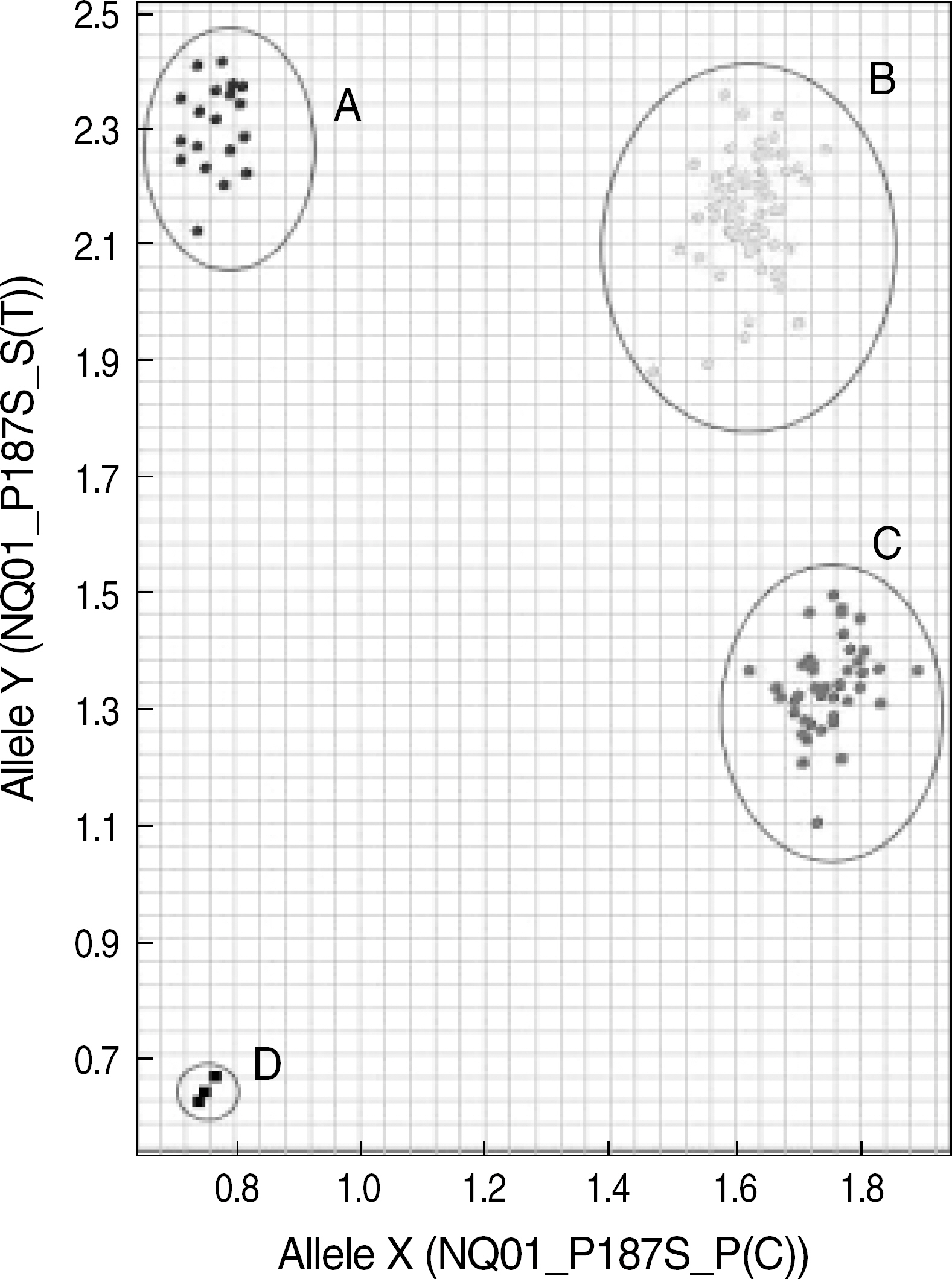Korean J Lab Med.
2006 Apr;26(2):71-76. 10.3343/kjlm.2006.26.2.71.
Association of NQO1 Polymorphism with Multiple Myeloma Risk in Koreans
- Affiliations
-
- 1Department of Laboratory Medicine, Seoul National University College of Medicine, Seoul, Korea. soonlee@plaza.snu.ac.kr
- 2Cancer Research Institue, Seoul National University College of Medicine, Seoul, Korea.
- KMID: 2238893
- DOI: http://doi.org/10.3343/kjlm.2006.26.2.71
Abstract
-
BACKGROUND: NAD(P)H:quinone oxidoreductase 1 (NQO1) is an important enzyme in the metabolism of xenobiotics. NQO1 609C -> T (NQO1*2) has been reported to be associated with reduced enzyme activity, benzene-induced hematotoxicity, and acute leukemia. Incidences of multiple myeloma show interethnic variation and exposure to asbestos, petroleum products, and diesel exhaust is a risk factor for multiple myeloma. We studied the associations of NQO1 polymorphism with multiple myeloma risk, stage, and prognostic factors (hemoglobin, calcium, beta2-microglobulin, M-protein and creatinine).
METHODS
The frequency of NQO1 polymorphism was investigated in 117 myeloma patients and 166 controls. NQO1 genetic polymorphism was determined by TaqMan allelic discrimination assay. Prognostic factors were obtained from the patients' medical records.
RESULTS
The frequencies of the NQO1*1/*1, *1/*2, and *2/*2 genotypes were 31.6%, 63.2%, and 5.1% in the patients, whereas the respective figures in the controls were 31.9%, 48.3%, and 19,9%. The frequency of NQO1*2/*2 was significantly lower in patients than in controls and the odds ratio (OR) was 0.24 (95% confidence interval: 0.01-0.68) to NQO1*1/*1 genotype, indicating a decreased risk for multiple myeloma. There were no significant differences in tumor stages and other prognostic factors among NQO1 genotypes.
CONCLUSIONS
A risk for multiple myeloma decreased in NQO1*2/*2 genotype in Koreans. We report, for the first time, that NQO1 polymorphism is associated with multiple myeloma risk.
MeSH Terms
Figure
Reference
-
References
1. Daniel B. The incidence and epidemiology of plasma cell neoplasms. Stem Cells. 1995; 13(Suppl 2):1–9.2. Yang SH, Kim TY, Kim BK, Koh YW, Kwak DS, Kim NK, et al. A statistical Study of Multiple Myeloma in Korea. Korean J Hematol. 1995; 30:345–61.3. Lee WJ, Baris D, Jarvholm B, Silverman DT, Bergdahl IA, Blair A. Multiple myeloma and diesel and other occupational exposures in Swedish construction workers. Int J Cancer. 2003; 107:134–8.
Article4. Ross D, Kepa JK, Winski SL, Beall HD, Anwar A, Siegel D. NAD(P)H: quinone oxidoreductase 1 (NQO1): chemoprotection, bioactivation, gene regulation and genetic polymorphisms. Chem Biol Interact. 2000; 129:77–97.5. Hajos AK, Winston GW. Purified NAD(P)H-quinone oxidoreductase enhances the mutagenicity of dinitropyrenes in vitro. J Biochem Toxicol. 1991; 6:277–82.
Article6. Siegel D, McGuinness SM, Winski SL, Ross D. Genotype-phenotype relationships in studies of a polymorphism in NAD(P)H:quinone oxidoreductase 1. Pharmacogenetics. 1999; 9:113–21.7. Rothman N, Smith MT, Hayes RB, Traver RD, Hoener B, Campleman S, et al. Benzene poisoning, a risk factor for hematological malignancy, is associated with the NQO1 609C→T mutation and rapid fractional excretion of chlorzoxazone. Cancer Res. 1997; 57:2839–42.8. Krajinovic M, Sinnett H, Richer C, Labuda D, Sinnett D. Role of NQO1, MPO and CYP2E1 genetic polymorphisms in the susceptibility to childhood acute lymphoblastic leukemia. Int J Cancer. 2002; 97:230–6.9. Smith MT, Wang Y, Kane E, Rollinson S, Wiemels JL, Roman E, et al. Low NAD(P)H:quinone oxidoreductase 1 activity is associated with increased risk of acute leukemia in adults. Blood. 2001; 97:1422–6.
Article10. Larson RA, Wang Y, Banerjee M, Wiemels J, Hartford C, Le Beau MM, et al. Prevalence of the inactivating 609C→T polymorphism in the NAD(P)H:quinone oxidoreductase (NQO1) gene in patients with primary and therapy-related myeloid leukemia. Blood. 1999; 94:803–7.
Article11. Durie BG, Salmon SE. Multiple myeloma, macroglobulinemia, and monoclonal gammopathies. Hoffbrand AV, Brain MC, editors. Recent advances in hematology. Edinberg: Churchill-Livingston;1977. p. 243–56.12. Shi MM, Myrand SP, Bleavins MR, de la Iglesia FA. High throughput genotyping for the detection of a single nucleotide polymorphism in NAD(P)H quinone oxidoreductase (DT diaphorase) using TaqMan probes. Mol Pathol. 1999; 52:295–9.
Article13. Durie BG, Salmon SE. A clinical staging system for multiple myeloma. Correlation of measured myeloma cell mass with presenting clinical features, response to treatment, and survival. Cancer. 1975; 36:842–54.
Article14. Kelsey KT, Ross D, Traver RD, Christiani DC, Zuo ZF, Spitz MR, et al. Ethnic variation in the prevalence of a common NAD(P)H quinone oxidoreductase polymorphism and its implications for anti-cancer chemotherapy. Br J Cancer. 1997; 76:852–4.
Article15. Chen H, Lum A, Seifried A, Wilkens LR, Le Marchand L. Association of the NAD(P)H:quinone oxidoreductase 609C→T polymorphism with a decreased lung cancer risk. Cancer Res. 1999; 59:3045–8.16. Menzel HJ, Sarmanova J, Soucek P, Berberich R, Grunewald K, Haun M, et al. Association of NQO1 polymorphism with spontaneous breast cancer in two independent populations. Br J Cancer. 2004; 90:1989–94.
Article17. Schulz WA, Krummeck A, Rosinger I, Eickelmann P, Neuhaus C, Ebert T, et al. Increased frequency of a null-allele for NAD(P)H: quinone oxidoreductase in patients with urological malignancies. Pharmacogenetics. 1997; 7:235–9.
Article18. Ross D. Metabolic basis of benzene toxicity. Eur J Haematol Suppl. 1996; 60:111–8.
Article19. Sonoda T, Nagata Y, Mori M, Ishida T, Imai K. Meta-analysis of multiple myeloma and benzene exposure. J Epidemiol. 2001; 11:249–54.
Article20. Wong O, Harris F, Rosamilia K, Raabe GK. An updated mortality study of Workers at a petroleum refinery in Beaumont, Texas, 1945 to 1996. J Occup Environ Med. 2001; 43:384–401.
Article21. Flodin U, Fredriksson M, Persson B. Multiple myeloma and engine exhausts, fresh wood, and creosote: a case-referent study. Am J Ind Med. 1987; 12:519–29.
Article22. Arlt VM, Stiborova M, Henderson CJ, Osborne MR, Bieler CA, Frei E, et al. Environmental pollutant and potent mutagen 3-nitrobenzanthrone forms DNA adducts after reduction by NAD(P)H:quinone oxidoreductase and conjugation by acetyltransferases and sulfotransferases in human hepatic cytosols. Cancer Res. 2005; 65:2644–52.
Article
- Full Text Links
- Actions
-
Cited
- CITED
-
- Close
- Share
- Similar articles
-
- An Association between 609 C --> T Polymorphism in NAD(P)H: Quinone Oxidoreductase 1 (NQO1) Gene and Blood Glucose Levels in Korean Population
- Interactive Effect of Smoking and NQO1 Haplotypes on Lung Cancer Risk
- Four Cases of Multiple Myeloma
- Multiple myeloma
- A Case of Multiple Myeolma with Huge Tumor Mass in Clavicle


